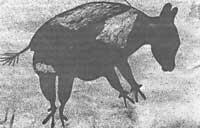Calapita of skulls
1989/01/01 Elhuyar Zientzia Iturria: Elhuyar aldizkaria
Both groups do not agree on the future of human bones found in Australia.
The skull is located on a sandy dune of Lake Mungo, west of New South Wales, and is partially excavated. Local Aborigines do not want archaeologists to extract themselves from the skull.
By the position of the skull, it is at least 36,000 years old and archaeologists believe that carbon dating (14) can give the skull an age of 40,000 years. In addition, it has been preserved very well, and the small bones of the face seem to remain intact.

The skull found in Mungia summarizes the problem of who has the right to human footprint in Australia. Archaeologists were tested when the governments of Commomwealth decided to return to the Aborigines the large collection of Aboriginal bones of the Melbourne Museum. According to the claims of the Aborigines, these skeletons will be reburied.
Most of the skeletons in this collection are about five thousand years old, but there are also skeletons of 12,000 and 15,000 years.
Archaeologists consider that this measure is not adequate. And it is not possible to affirm that the current aborigines are their heirs of yesteryear. The Aboriginal older people strongly value these opinions and firmly believe that their ancestors have always lived in Australia. The younger Aborigene use favorable evidence for human colonization in Australia 50,000 thousand years ago to defend the same point as their superiors.
The ancient Australian fossil and the current DNA of the Aborigines can have a great value to unravel the world expansion of man for 100,000 years from Africa and the Middle East. With this argument, archaeologists affirm that the skulls of Mungia and similar cases are non-aboriginal heritage and of all mankind. In addition, they add their conformity with the reburring of skeletons directly related to the current aboriginal populations.
The problem is not easy and the two parties are right. The natives have all the right to care for their ancestors and, on the other hand, humanity has the right to analyze everything that can help describe their history.

Gai honi buruzko eduki gehiago
Elhuyarrek garatutako teknologia





